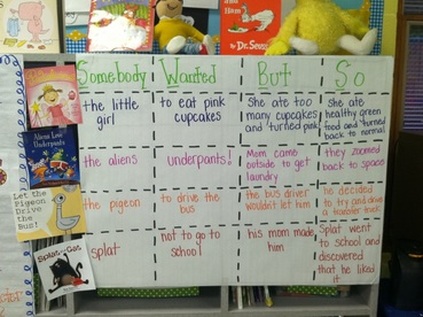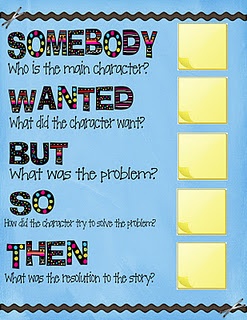What is SWBS?
|
Videos |
|
SWBS (Somebody Wanted But So) is an organized way to summarize reading. This strategy works well for struggling readers, as it assists them in deciphering what is important parts of the text to include in a summary. Using this strategy as a guide, students read a story or text, then decide who the somebody is, what that person or character wanted, but what happened that prevented it from happening, and so how they overcame or how it all ended.
Kylene Beers, author of When Kids Can't Read identifies SWBS as a strategy to use. She says, "SWBS also moves students beyond summary writing. As students choose names for the Somebody column, they are really looking at characters trying to decide which are the main characters. In the Wanted column, they look at the events of the plot and immediately talk about main ideas and details. In the But column, they are examining conflict. With the So column, they are looking at resolutions" (2003). This reading strategy is simple, easy, and fun for students to use. They enjoy the simplicity of the strategy and sharing what they read with other students. Jan Rozzelle and Carol Searce, in Power Tools for Adolescent Literacy describe the benefits of using SWBS as a reading strategy. "While the SWBS tool is typically used after reading, it can also be used during reading of specific chapters or a section of the text to outline the main plot as well as subplots. SWBS is a good way to summarize. It is fun and energizes students when they work together to create one or they listen to the other students share their summaries" (2009). |
In the video below, second grade students are seen using the SWBS strategy to assist them in summarizing a text. This video shows students excited about their reading and sharing what they have read.
|
How can I use this Strategy?
This strategy works best with fiction or stories, where students can identify characters, plot, climax, and resolution.
|
Resources
|
Incorporate Writing
This strategy expects students to write a summary to a story the have read, which connects to CCSS.ELA-LITERACY.W.6.3 which states, "Write narratives to develop real or imagined experiences or events using effective technique, relevant descriptive details, and well-structured event sequences" (English Language Arts, n.d.)
|
Examples:
References:
Beers, K. (2003). When kids can't read, what teachers can do: A guide for teachers, 6-12. Portsmouth, NH: Heinemann.
English Language Arts Standards » Writing » Grade 6. (n.d.). Retrieved May 18, 2015, from http://www.corestandards.org/ELA-Literacy/W/6/
Nikas, J., & Scearce, C. (2009). Power tools for adolescent literacy: Strategies for learning. Bloomington, IN: Solution Tree.
Beers, K. (2003). When kids can't read, what teachers can do: A guide for teachers, 6-12. Portsmouth, NH: Heinemann.
English Language Arts Standards » Writing » Grade 6. (n.d.). Retrieved May 18, 2015, from http://www.corestandards.org/ELA-Literacy/W/6/
Nikas, J., & Scearce, C. (2009). Power tools for adolescent literacy: Strategies for learning. Bloomington, IN: Solution Tree.


